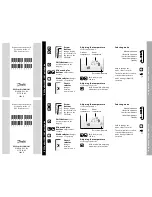
S.B.C. Elettronica S.p.A. - Engineering Division
HPDxxN – High Power User’s Manual
34
of X2 and channel 2 to terminal 7 of X2. The V/div scale and the timebase are not mentioned as
they may vary considerably.
CALCULATING Pr16
The value of Pr16 should be calculated before enabling the drive. Pr16 defines system gain. To
convert Pr16 into degrees for rated torque use the formula:
ac
=
⋅
Pr
Pr
33
16
28
where ac is the stiffness
angle. Obviously, before the formula can be used Pr33 must be set to motor rated current. To
evaluate ac correctly we shall consider that, if the driven machine transmission is rigid (not flexible)
and there is no transmission backlash, the optimal stiffness angle could be around 4 degrees. If the
transmission is not sufficiently rigid it may be necessary to reduce gain. If motor torque has been
selected to achieve steep acceleration ramps, while dynamic torque changes in normal operation are
minimal, stiffness angles of 20, 30 or 40 degrees are acceptable without negatively affecting
performance. If you encounter difficulty in choosing the most appropriate stiffness angle, start from
10 degrees, which is the default value when using a motor with the same rated current as the drive.
Now enter the calculated value for Pr16 and start the motor with a square wave reference signal
(pay attention when setting the reference amplitude and frequency to avoid problems in the case of
limited stroke axes). On the oscilloscope note that the response changes as Pr17 is altered.
Lowering Pr17 will allow you to approach system response as shown in figure 2.
Fig.2
For higher values of Pr17 system response will resemble the situation of figure 3 below.
















































